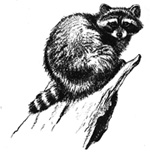Habitat - Teacher's Guide |
Episode Overview This episode opens with Junior Naturalist Patrice looking at how all living things need a habitat where their needs can be met. Next Patrice joins Senior Naturalist Dave Erler as they look at how the Squam Lakes Natural Science Center has created an artificial habitat in its aviary. Then we take an up-close look at the common loon and its habitat. Finally, Stevie and Taylor help biologist Kathy Wohlfort float a loon raft. This episode opens with Junior Naturalist Patrice looking at how all living things need a habitat where their needs can be met. Next Patrice joins Senior Naturalist Dave Erler as they look at how the Squam Lakes Natural Science Center has created an artificial habitat in its aviary. Then we take an up-close look at the common loon and its habitat. Finally, Stevie and Taylor help biologist Kathy Wohlfort float a loon raft.
Program ObjectivesStudents will:1. Students will understand that environments support a diversity of living organisms that all share limited resources. 2. Analyze how living organisms need specific conditions and resources to survive in an environment. 3. Compare and contrast various habitats. 4. Distinguish between living and nonliving components of a habitat. 5. Describe what an organism needs in a habitat to survive. 6. Describe the habitats of various organisms. 7. Recognize the distinct characteristics of the loon. 8. Describe the common loon in relationship to its habitat needs. 9. Describe how the seasonal changes in habitat affect the common loon. Vocabulary
Previewing ActivityHave students brainstorm different places animals live. After they come up with a variety of habitats, have students list the things in those habitats that would help an organism survive. Post-Viewing Activities1. Have students "adopt" an area outside their school or home. The area they adopt should be small, like a tree, rotting log, bush, patch of grass or garden. Over a period of two weeks or longer, have them record activity in their area. They should record weather, time of day observed, animals and plants that make their habitat in that area, the niche the plants and animals fill, animal activity or signs, plant growth and any other changes that occur, such as the grass being cut, or the flowers dying. At the end of the observation period, have the students write a "biography" that traces the life of their area for the period they observed it. 2. Have the students research local plant or animal habitats that are endangered or in trouble and draw up an action plan for saving those habitats. A local endangered habitat may be large or small. It could be a local stream, a patch of grass in the school yard that has lost its vegetation because kids are walking on it, or a tree that is in danger of being cut down. An action plan may be a letter-writing or email campaign to local media and politicians, it could be a public awareness campaign at the school or in the community, or it might involve organizing a clean up of a habitat. 3. Have the students research the use of lead sinkers in their state and the impact they are having on wildlife. They can contact the local chapter of the Audubon Society or the state's Fish and Game or Wildlife Office to find out about lead sinker use.
| Hands-On:Whatever Floats Your Boat In
this episode of NatureWorks, students learned that loons have solid bones
that make takeoffs and landings difficult but make diving easier. They also
learned how this structural adaptation impacts where the loon can live. In this experiment, students will explore buoyancy. Materials Neededwater ProcedureWorking in groups, have the students fill the tubs with water and float the straws. Then have them cut the straws open and fill them with modeling clay and place them in water. The straws should now sink. Next, have the students create a "loon skeleton" using clay-filled straws. The skeleton should include a body, a head and neck and wings. They can connect the skeleton with tape. Have them try to float the skeleton and record what happens. Finally, have them create a body for their loons with newspaper and aluminum foil. The newspaper should be the stuffing and the aluminum foil the covering. Have them work on the loon body until it floats. Additional Resources101 Things You Can Do to Save Animal Habitats Explore the Fantastic Forest Books A Dead Log by Jen Green The Legend of the Loon by Kathy-Jo Wargin, illustrations by Gisbert Van Frankenhuyzen |
